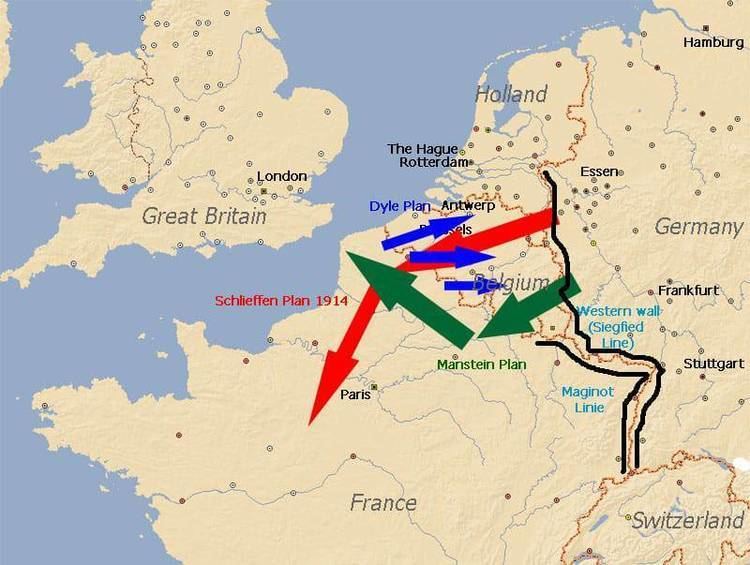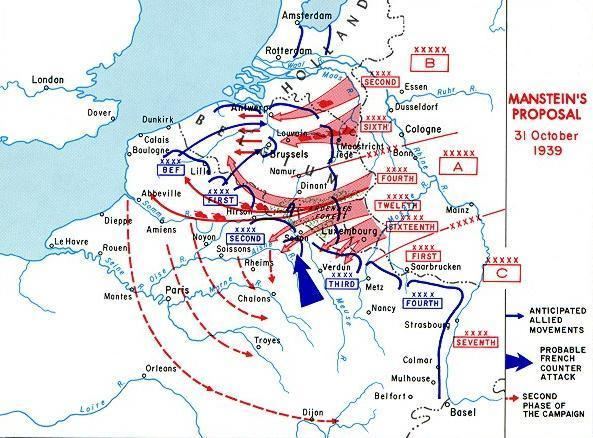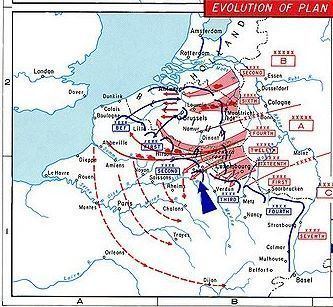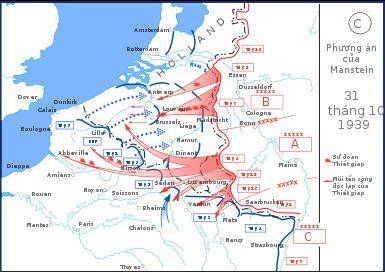Operational scope Strategic Date 10 May 1940 | Planned 1940 Result Victory | |
 | ||
Objective Defeat of the Netherlands, Belgium and France | ||
The Manstein Plan is one of the names used to describe the war plan of the German Army during the Battle of France in 1940. The original invasion plan was a compromise devised by Franz Halder and satisfied no-one. Some documents containing details of the plan fell into Belgian hands during the Mechelen incident of 10 January 1940 and the plan was revised several times. The versions of the plan increased the emphasis of an attack by Army Group A through the Ardennes, which progressively reduced an offensive by Army Group B through the Low Countries to a diversion.
Contents

By coincidence, in the eventual version of the plan, the main effort of the German invasion was made against the Ardennes, the weakest part of the Allied line, where defence was left to second-rate French divisions, while the Seventh Army, the most powerful part of the French strategic reserve, was committed to an attempt to join with the Dutch Army far to the north, in the Breda variant of Plan D, the Allied deployment plan.

Background
The Manstein Plan was a counterpart to the French Dyle Plan for the Battle of France. Lieutenant General Erich von Manstein dissented from the 1939 versions of Fall Gelb (Case Yellow), a plan for an invasion of France and the Low Countries, devised by Franz Halder. The original Aufmarschanweisung N°1, Fall Gelb (Campaign Instruction No 1, Case Yellow), was a plan to push the Allied forces back through central Belgium to the Somme river, in northern France, with similarities to the 1914 campaign of the First World War. On 10 January 1940, the Mechelen Incident occurred, when a German aircraft carrying documents with parts of the operational plans for Fall Gelb crashed in Belgium, prompting another review of the invasion plan. Fall Gelb was revised by Halder, not fundamentally changing it in Aufmarschanweisung N°3, Fall Gelb, Manstein was able to convince Hitler in a meeting on 17 February, that the Wehrmacht strategy should be an attack through the Ardennes, followed by an advance to the coast.
Prelude

Manstein, chief of staff of Army Group A, had originally formulated his plan in October 1939 in Koblenz on the instigation of his commander General Gerd von Rundstedt, who rejected Halder's plan, through rivalry and because it would not lead to a decisive victory over France. Manstein first thought to follow annihilation theory (Vernichtungsgedanke), envisaging a swing from Sedan to the north, rapidly to annihilate the Allied armies in a cauldron battle (Kesselschlacht). When discussing his intentions with Lieutenant-General Heinz Guderian, commander of the XIX Panzer Corps, the latter proposed to turn it into a strategy to avoid the main body of the Allied armies and swiftly advance with the armoured divisions to the English Channel, to cause the Allies to collapse by catching them off guard and cutting their supply lines. It was thus Guderian who introduced the true "Blitzkrieg" elements to the plan, while Manstein had at first many objections against this aspect, especially fearing the long open flank created by such an advance. Guderian managed to convince him that the danger of a French counterattack from the south could be averted by a simultaneous secondary spoiling offensive to the south, in the general direction of Reims.

When Manstein first presented his ideas to the OKH, he did not mention Guderian and made his swing to the north the main effort, while a limited number of armoured divisions protected the left flank of this movement, acting in a classic cavalry strategic reconnaissance role. These changes did not reflect a change of mind on his part but were included because the original conception was too radical to be acceptable and many conservative generals also considered Guderian too radical. His views were rejected by Halder and Walther von Brauchitsch. Reformulating them in a more radical sense did not help and in late January, Halder removed Manstein by having him promoted commander of XXXVIII Army Corps in east Germany. (Manstein and Halder were old rivals: in 1938 Manstein had been the successor of chief of staff Ludwig Beck but had been ousted when the latter fell into disgrace with Hitler over the Blomberg-Fritsch Affair.) On 1 September 1938, Halder had replaced Beck instead of Manstein.

In late January, Lieutenant-Colonel Günther Blumentritt and Major Henning von Tresckow, part of Manstein's staff, contacted Hitler's Army attaché, Lieutenant Colonel Rudolf Schmundt (an old acquaintance of Tresckow's) when he was visiting Koblenz, who informed Hitler of the affair on 2 February. Having found Halder's plans unsatisfactory from the very beginning, Hitler ordered a change of strategy on 13 February in accordance with Manstein's thinking, having heard an outline. The general was invited to the Reich Chancellery in Berlin to explain his plans to Hitler on 17 February, during a working lunch in the presence of Alfred Jodl and Erwin Rommel. Though Hitler felt an immediate antipathy against Manstein for being too arrogant and aloof, he listened speechlessly to his exposition and was impressed by Manstein's logic. "Certainly an exceptionally clever fellow, with great operational gifts, but I don't trust him" Hitler remarked after Manstein had left.
Plan
Manstein took no more part in the planning and returned to east Germany. Halder had to revise the plan again, which became Aufmarschanweisung N°4, Fall Gelb. The new plan conformed to Manstein's thinking in that Army Group A would provide the main thrust of the invasion through the Ardennes in southern Belgium. After crossing the Meuse River between Namur and Sedan, Army Group A would turn north-west towards Amiens, while Army Group B executed a feint attack in the north to lure the Allied armies forward into Belgium and pin them down. The revision was a substantial change in emphasis, in which Halder no longer envisaged a simultaneous secondary attack to the west but made it the main effort (Schwerpunkt). The dash for Abbeville was removed, river crossings were to be forced by infantry and there would be a long consolidation phase, while a large number of infantry divisions crossed into the bridgeheads. The armoured divisions should then advance together with the infantry divisions, not in an independent operational penetration. Halder rejected the idea simultaneous attack to the south to occupy the area that the French would want to use to deploy for a counter-offensive, to defeat the attempt before it began.
Battle
Five panzer divisions of Panzergruppe von Kleist advanced through the Ardennes, XIX Panzer Corps with three panzer divisions on the southern flank towards Sedan against the Second Army and the XLI Panzer Corps with two panzer divisions on the northern flank, towards Monthermé against the Ninth Army. The XV Corps moved through the upper Ardennes with two panzer divisions towards Dinant as a flank guard against a counter-attack from the north. From 10–11 May, the XIX Panzer Corps engaged the two cavalry divisions of the Second Army, surprised them with a far larger force than expected and forced the French back. The Ninth Army to the north had also sent its two cavalry divisions forward, which were withdrawn on 12 May before they met German troops. Corap needed the cavalry divisions to reinforce the defences on the Meuse, because some of the infantry had not arrived. The most advanced German units reached the Meuse in the afternoon but the local French commanders thought that they were far ahead of the main body and would wait before trying to cross the Meuse. From 10 May, Allied bombers had been sent to raid northern Belgium to delay the German advance while the First Army moved up; attacks on the bridges at Maastricht had been costly failures, 135 RAF day bombers being reduced to 72 operational aircraft by 12 May.
Against the plan, Guderian and the other panzer generals, Rommel among them, disobeyed orders and quickly advanced to the English Channel. The panzer forces captured Abbeville and fought the Battle of Boulogne and the Siege of Calais, only temporarily being halted by Hitler on 17, 22 and 24 May, then advancing again and fighting the Battle of Dunkirk. The effects of the Manstein Plan were devastating for the Allied armies, as they were encircled by Army Groups A and B, leading to Operation Dynamo, the evacuation from Dunkirk. The losses in the north and resulting lack of mobile reserves led to the defeat of the remaining French forces and complete victory over France.
Analysis
This resounding success came as a complete surprise even to the Germans, who hardly had dared to hope for such an outcome. Most generals had vehemently opposed the plan as being much too risky; even those supporting it had mainly done so out of desperation because the geostrategic position of Germany seemed so hopeless. Count Ciano later in the war observed that "victory has a hundred fathers, but defeat is an orphan" and Fall Gelb would have no lack of sires. Two of the most prominent were Hitler and Halder. Because Hitler had not liked Halder's original plans, he had suggested many alternatives, some of them bearing a resemblance to the Manstein Plan, the closest being a proposal made by him on 25 October 1939. Soon, Nazi propaganda began to claim that the victory was a result of Hitler's military genius; Hitler said,
Of all the generals, with whom I spoke about the new attack plan in the West, Manstein was the only one who understood me!
After the war, Halder claimed he was the main inventor of the German plan, supporting this with the fact that he had begun considering to change the main axis to Sedan as early as September 1939 and that Manstein's original proposal was too traditional.
The Manstein Plan is often seen as either the result of or the cause of a mid-20th century Revolution in military affairs. In the former hypothesis, expounded by Fuller and Basil Liddell Hart immediately after the events, the Manstein Plan is presented as a natural outcome of the evolution of German military thinking in the twenties and thirties by Hans von Seeckt and Guderian, adopting the ideas of Fuller or Liddell Hart. If true, an explicit Blitzkrieg doctrine would have been established by 1939 and been the basis of the plan for the Invasion of Poland; the Manstein Plan would have been its most spectacular implementation. The doctrine would have been reflected in the organisation and equipment of the army and the Luftwaffe and would have been radically different from those of France, Britain and the Soviet Union, except for the contributions of individuals like Mikhail Tukhachevsky, Charles de Gaulle, Fuller and Liddell Hart. That the earliest plans by Halder or Manstein and the final plan by Halder did not conform to this doctrine is an anomaly, to be explained by circumstances.
In the latter hypothesis, promoted by Robert Allan Doughty and Karl-Heinz Frieser, the Manstein Plan was a return to the principles of 19th century Bewegungskrieg (war of manoeuvre), adapted to modern technology by a sudden and unexpected departure from established German doctrine, through the Blitzkrieg elements provided and executed by Guderian. The influence of Fuller and Liddell Hart in Germany was limited and much exaggerated by the two writers after the war; no explicit Blitzkrieg doctrine can be found in pre-war German army records. German tank production had no priority and plans for the German war economy were based on the premise of a long war, not a swift victory. The hypothesis allows for a gradual adoption during the thirties of technologically-advanced military equipment and integration into an existing Bewegungskrieg doctrine familiar to all the great powers prior to 1940, the differences between the nations being variations on a theme. The invasion of Poland was not a Blitzkrieg campaign but a classic annihilation battle fought according to Vernichtungsgedanke (annihilation theory). The lack of Blitzkrieg elements in the plans for Fall Gelb is seen as unremarkable; only after the crossing of the Meuse at various points, the sudden success of the breakout and the insubordination of Guderian and other tank commanders during the rush along the Somme valley, would Blitzkrieg have been adopted as an explicit doctrine, in this view making Operation Barbarossa the first deliberate Blitzkrieg campaign.
Guderian presented the situation in his postwar book Erinnerungen eines Soldaten Memories of a Soldier 1950, published in English as Panzer Leader), according to the second hypothesis, portraying himself as a lone voice against a reactionary majority of the German officer corps. In 2006, Adam Tooze wrote that the quick victory in France was not the consequence of a logical strategic synthesis but a "risky improvisation" to cope with strategic dilemmas that Hitler and the German military leaders had failed to overcome before February 1940. The Allies and the Germans had no interest in acknowledging the importance of improvisation and chance in the sensational victory of 1940, the fabrication of a Blitzkrieg Myth was convenient for the Allies, to hide the incompetence that had led to defeat. Rather than resort to technological determinism, German propaganda emphasised the machinery of the German army and that of the Allies, juxtaposing it with the heroic individualism of German soldiers, notably in the film Sieg im Westen (1941). OKW explained the victory as a consequence of the "...revolutionary dynamic of the Third Reich and its National socialist leadership".
Tooze wrote that a debunking of a technological interpretation of the German victory in France, should not lead to the conclusion that it was the genius of Manstein or the superiority of German soldiers that caused the victory. There was no grand German strategic synthesis, the course of the 1940 campaign depended on the economic mobilisation of 1939 and the geography of western Europe. During the winter of 1939–1940, the quality of German armoured forces was substantially improved and the plan attributed to Manstein was not a revolutionary departure from traditional military thinking but the concentration of superior force at the decisive point, a synthesis of "materialism and military art". The German army committed all its armoured units to the offensive and had it failed, would have had no mobile units to resist an Allied counter-offensive. Casualties were high but with the swift end to the campaign were bearable. The Luftwaffe was also fully committed but the Allied air forces held back a substantial reserve, in anticipation of a longer campaign. The Luftwaffe was able to gain air superiority but at a far greater cost in losses than that of the army. On 10 May, Luftwaffe losses were 347 aircraft and by the end of the month 30 percent of Luftwaffe aircraft had been written off and 13 percent badly damaged. The concentration of units in the Ardennes was an extraordinary gamble and had the Allied air forces been able to bomb the columns, chaos could have been created. The "audacious" manoeuvre of Army Group A concerned only about twelve armoured and motorised divisions, while most of the rest of the German army invaded on foot, supplied from railheads.
The Channel coast was a natural obstacle, only a few hundred kilometres from the German border and over such a distance, motorised supply from railheads could function, using the dense west European road network and by living off the land, amidst the highly developed agriculture of western Europe, unlike in Poland where it had been much harder to maintain momentum. Tooze concluded that although the German victory of 1940 was not determined by brute force, the Wehrmacht did not rewrite the rules of war or succeed only because of the ardour of German soldiers and French pacifism. The odds against Germany were not so extreme as to be insurmountable by better planning for an offensive based on the familiar principles of Bewegungskrieg (manoeuvre warfare). The German army managed to concentrate a hugely powerful force at the decisive point but took a gamble of great magnitude that could not be repeated if the attack failed. When the Germans attempted to repeat the success of 1940 against the Soviet Union in 1941, little was left in reserve. The Red Army had a greater margin of numerical superiority, better leadership and more room for manoeuvre and the Napoleonic principle of the concentration of superior force at the decisive point was impossible for the Germans to achieve.
In the 2014 edition of Breaking Point, Doughty described how in a 1956 publication, Fuller wrote that the Battle of Sedan was an "attack by paralysation" that he had devised in 1918 and incorporated into Plan 1919. Doughty wrote that although the Germans hoped for a quick victory, there is little evidence to support Fuller and that if military theory later labelled Blitzkrieg were influential in the German officer corps, only those like Manstein and Guderian had fully accepted it. The disagreement between Kleist and Guderian that led Guderian to resign on 17 May, showed the apprehensions of the German high command about the speed of movement and vulnerability of the XIX Panzer Corps. Doughty suggested that the development of the Manstein Plan showed that the force sent through the Ardennes was intended to follow a familiar strategy of Vernichtungsgedanke intended to encircle and annihilate the Allied armies in Kesselschlachten (cauldron battles). Twentieth century weapons were different but the methods little changed from those of Ulm (1805), Sedan (1870) and Tannenberg (1914). When German forces broke through on 16 May, they did not attack French headquarters but advanced westwards in the manner of a cavalry raid.
Doughty wrote that Fuller had called the advanced forces of the German army an armoured battering-ram, covered by Luftwaffe fighters and dive-bombers acting as flying field artillery, to break through a continuous front at several points. The XIX, XLI and XV panzer corps had operated as the leading force through the Ardennes but the most effective Allied resistance to the south and south-west of Sedan was reduced by the combined operations of infantry, tanks and artillery, a fact overlooked for long after 1940. Luftwaffe bombers had not acted as flying artillery and their main effect was on 13 May, when bombing collapsed the morale of the 55th Division. Air attacks helped the ground forces to advance but destroyed few tanks and bunkers, most of which were taken by the skill and determination of German infantry, sometimes helped by the fire of anti-tank guns, accompanying guns and a few tanks. Fuller's writing was in the vein of much of the early reports of the Battle of France but since then new studies had added nuance, dwelling on the complications and chaos of the military operations. The Manstein Plan led to much more than a simple tank rush through the Ardennes and the fields of northern France; the toughness and training of the German infantry should be recognised, along with the efforts of the engineers and artillery, which got the XIX Panzer Corps across the Meuse.
Doughty also wrote that the success of the German army could not adequately be explained without reference to French mistakes. French strategy was unusually vulnerable to an attack through the Ardennes; operationally, French commanders failed adequately to react to the breakthrough of massed panzer forces. Tactically, the Germans were often able to overcome French defences that usually were inadequate. French military intelligence failed to predict the main German attack, expecting it in central Belgium as late as 13 May. Military intelligence had made the elementary mistake of noting information that fitted with their assumptions of German intentions and paid insufficient attention to German capability or information suggesting that they were not conforming to expectations. Doughty wrote that the French failure was caused by an inadequate military system and had much to do with the success of the German invasion. The French had prepared to fight a methodical battle based on massed firepower, against an opponent that emphasised surprise and speed. French training for a centralised and slow-moving battle left the army incapable of hasty counter-attacks or bold moves. The French army lost the initiative, were overrun at important points and then deep German penetrations made the disruption of French command arrangements worse.
Sichelschnitt
It is common in the literature to call the Manstein plan Operation Sichelschnitt and this had led to a misunderstanding that this was the official name of the plan or at least of the attack by Army Group A, the real title was Aufmarschanweisung N°4, Fall Gelb as issued on 24 February 1940 and the manoeuvre through the Ardennes had no name. Sichelschnitt originated in this context as a literal German translation of "sickle cut", a catchy expression used after the events by Winston Churchill. After the war, it was used in the writings of German generals.
